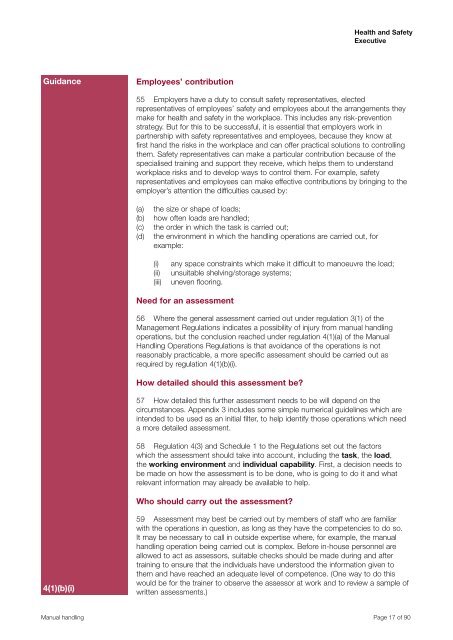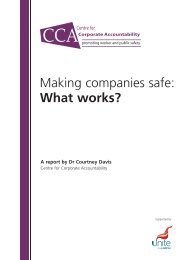Manual Handling Manual Handling Operations Regulations 1992 ...
Manual Handling Manual Handling Operations Regulations 1992 ...
Manual Handling Manual Handling Operations Regulations 1992 ...
Create successful ePaper yourself
Turn your PDF publications into a flip-book with our unique Google optimized e-Paper software.
Health and Safety<br />
Executive<br />
Guidance<br />
Employees’ contribution<br />
55 Employers have a duty to consult safety representatives, elected<br />
representatives of employees’ safety and employees about the arrangements they<br />
make for health and safety in the workplace. This includes any risk-prevention<br />
strategy. But for this to be successful, it is essential that employers work in<br />
partnership with safety representatives and employees, because they know at<br />
first hand the risks in the workplace and can offer practical solutions to controlling<br />
them. Safety representatives can make a particular contribution because of the<br />
specialised training and support they receive, which helps them to understand<br />
workplace risks and to develop ways to control them. For example, safety<br />
representatives and employees can make effective contributions by bringing to the<br />
employer’s attention the difficulties caused by:<br />
(a)<br />
(b)<br />
(c)<br />
(d)<br />
the size or shape of loads;<br />
how often loads are handled;<br />
the order in which the task is carried out;<br />
the environment in which the handling operations are carried out, for<br />
example:<br />
(i)<br />
(ii)<br />
(iii)<br />
any space constraints which make it difficult to manoeuvre the load;<br />
unsuitable shelving/storage systems;<br />
uneven flooring.<br />
Need for an assessment<br />
56 Where the general assessment carried out under regulation 3(1) of the<br />
Management <strong>Regulations</strong> indicates a possibility of injury from manual handling<br />
operations, but the conclusion reached under regulation 4(1)(a) of the <strong>Manual</strong><br />
<strong>Handling</strong> <strong>Operations</strong> <strong>Regulations</strong> is that avoidance of the operations is not<br />
reasonably practicable, a more specific assessment should be carried out as<br />
required by regulation 4(1)(b)(i).<br />
How detailed should this assessment be?<br />
57 How detailed this further assessment needs to be will depend on the<br />
circumstances. Appendix 3 includes some simple numerical guidelines which are<br />
intended to be used as an initial filter, to help identify those operations which need<br />
a more detailed assessment.<br />
58 Regulation 4(3) and Schedule 1 to the <strong>Regulations</strong> set out the factors<br />
which the assessment should take into account, including the task, the load,<br />
the working environment and individual capability. First, a decision needs to<br />
be made on how the assessment is to be done, who is going to do it and what<br />
relevant information may already be available to help.<br />
Who should carry out the assessment?<br />
4(1)(b)(i)<br />
59 Assessment may best be carried out by members of staff who are familiar<br />
with the operations in question, as long as they have the competencies to do so.<br />
It may be necessary to call in outside expertise where, for example, the manual<br />
handling operation being carried out is complex. Before in-house personnel are<br />
allowed to act as assessors, suitable checks should be made during and after<br />
training to ensure that the individuals have understood the information given to<br />
them and have reached an adequate level of competence. (One way to do this<br />
would be for the trainer to observe the assessor at work and to review a sample of<br />
written assessments.)<br />
<strong>Manual</strong> handling Page 17 of 90
















